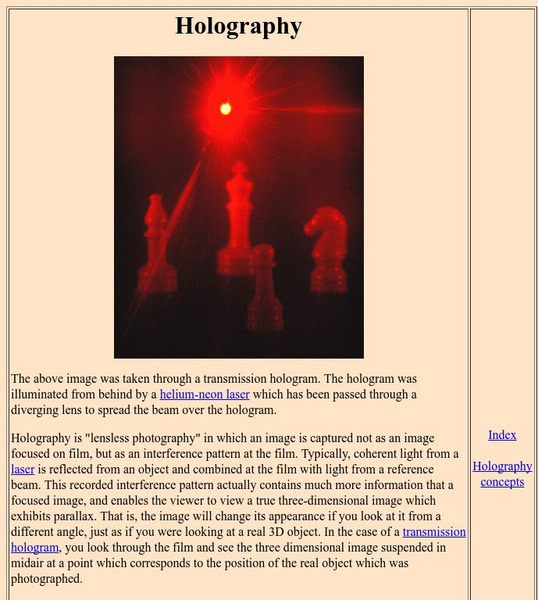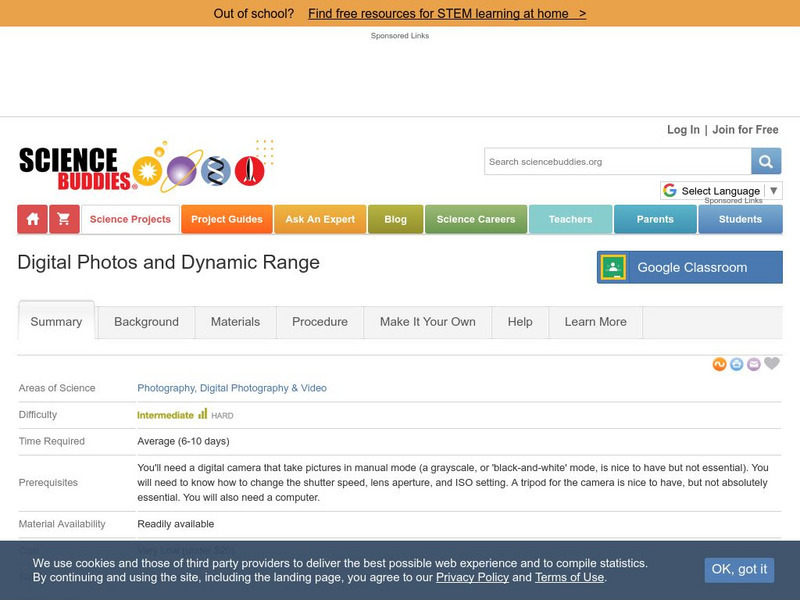Library of Congress
Loc: Popular Photographic Print Processes
This link is designed in a historic presentation to explain the various processes and functions of photography.
Library of Congress
Loc: The Empire That Was Russia, Photographic Record Recreated
The digital revival of the glass plate images of the Russian Empire on the eve of World War I by photographer Sergei Mikhaylovich Prokudin-Gorskii. Very interesting from both historical and technological points of view.
Georgia State University
Georgia State University: Hyper Physics: Holography
A definition and explanation of holography. Explains the process of making holograms and discusses the history and properties of holograms.
Art Cyclopedia
Artcyclopedia: Alphabetical Listing of Photographers
ArtCyclopedia offers a list of notable photographers from the formation of the media to the present--and links to biographies and works.
Library of Congress
Loc: Photographs of the Detroit Publishing Company: 1880 1920
An online collection of historical and archival photographs from the Detroit Publishing Company that show American life, industry, agriculture, and more from this period of rapid change.
University of Michigan
Floral Radiographs: The Secret Garden
A gallery depicting "floral radiographs," this website shows several examples of "this unusual art form" which shows "the secret beauty that lies hidden within [flowers'] blossoms." These black and white radiographs are done by Albert...
US National Archives
Nara: Picturing the Century: 100 Years of Photography
From the National Archives and Records Administration, this online exhibit has galleries of photographs separated by time period showing a history of the United States.
University of Texas at Austin
U of Texas: Photojournalism and the American Presidency
The University of Texas, Austin, explores photojournalism with images of recent American presidents and their times. Nixon, Ford, Carter, Reagan, Bush and Clinton are shown.
University of Texas at Austin
University of Texas, Austin: David Douglas Duncan
An informative site on David Douglas Duncan, a photojournalist active during and after World War II. While a U.S. marine, he photographed scenes of war; when his service ended, he photographed famous people like Picasso. He also wrote 30...
University of Chicago
American Environmental Photographs 1891 1936
An interesting site that shows early photographs by Henry Chandler Cowles and George Damon Fuller and others. The images range from ecological settings to the consequences of human changes to the environment.
Science Buddies
Science Buddies: Camera Lens Testing
This activity helps students learn more about cameras, and how to take better pictures.
Science Buddies
Science Buddies: Digital Photo Resolution
Do you have a favorite picture? When you have a photo that you treasure, you want it to look as good as possible. Find out how the resolution of a digital photo effects the way it looks when you print it out. How does the quality of the...
Science Buddies
Science Buddies: Color Saturation
Lively, vivid colors can add pizzazz and turn a dull photo into a work of art. Learn how changing the saturation levels of the colors in your photo can really make it pop.
Science Buddies
Science Buddies: Photography With Near Infrared Illumination
Have you ever wondered what it would be like to have an extra sense? What if you could hear above the normal range (ultrasound) like dogs or bats? This project shows you how you can use a camera, tripod and a special filter to take...
Science Buddies
Science Buddies: Digital Pinhole Camera
If you sit under a leafy tree on a sunny day, you may notice spots of sunlight on the ground from light passing through spaces between the leaves. Try putting a piece of cardboard on the ground and examining the spots of light on the...
Science Buddies
Science Buddies: Digital Photo Contrast
What do you do if you take a photo and it turns out too dark or too bright? You can use your computer to fix it for you. In this experiment you will investigate how changing the contrast of a digital photo will change the colors and...
Science Buddies
Science Buddies: Color Profiles
Did you know that the same digital photo you see on a computer monitor may not look as good in print? When it comes to color profiles, there are a lot of options: RGB, CMYK, grayscale and indexed color are just a few. Learn how to choose...
Science Buddies
Science Buddies: Bit Depth, Colors and Digital Photos
How many bits of information are in a digital photo? It depends on how many possible colors there are. Learn how to choose the right number of colors and bits to post your photo on the web or send it to your best friend.
Science Buddies
Science Buddies: Pinholes, Light and Aperture Size
Pinhole cameras are not a thing of the past. Even compared to all of the latest technology, a pinhole camera still gets beautiful results. Find out how this very simple aperture design works to control the way light enters the lens of...
Science Buddies
Science Buddies: Macro for Micro?
If the prefix "macro" means large and "micro" means small, then why will the macro setting of a digital camera help take a better picture of a small object? Do this experiment and get the big picture.
Science Buddies
Science Buddies: The Golden Rules of Photography
What is it that famous photographers do to make their images so pleasing to the eye? Find out if simple rules of geometry and symmetry can make you a better photographer.
Science Buddies
Science Buddies: Focusing Your Flash for 'Freezing' Motion
Here's an interesting flash photography project. With an inexpensive Fresnel lens, you can concentrate the light from your flash. You'll be able to shoot with a smaller aperture and a shorter flash duration. This will give you a greater...
Science Buddies
Science Buddies: Measuring Height or Distances With a Camera
If you know or calculate the field of view for your camera, you can use it to measure distances and the height of almost anything. It's all a matter of basic trigonometry.
Science Buddies
Science Buddies: Digital Photos and Dynamic Range
Digital cameras can be a great way to learn about photography. Most digital cameras today have LCD screens, so you get instant feedback on your photo. If you make a mistake, no problem, you just delete the picture. It's nice that you...























